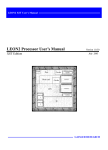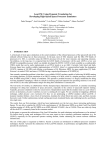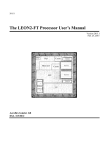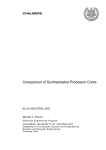Download GRMON User`s Manual - Engineering School Class Web Sites
Transcript
GRMON GRMON User’s Manual Version 1.0.13 July 2005 GAISLER RESEARCH AB -2- GRMON User’s Manual Copyright 2004, 2005 Gaisler Research AB. Permission is granted to make and distribute verbatim copies of this manual provided the copyright notice and this permission notice are preserved on all copies. Permission is granted to copy and distribute modified versions of this manual under the conditions for verbatim copying, provided also that the entire resulting derived work is distributed under the terms of a permission notice identical to this one. Permission is granted to copy and distribute translations of this manual into another language, under the above conditions for modified versions. GAISLER RESEARCH AB -3- GRMON User’s Manual 1 Introduction.................................................................................. 5 1.1 1.2 1.3 1.4 1.5 1.6 2 Overview........................................................................................................ Supported platforms and system requirements .............................................. Obtaining GRMON........................................................................................ Installation...................................................................................................... GRMON Evaluation version.......................................................................... Problem reports.............................................................................................. 5 5 5 5 5 5 Debugging concept ...................................................................... 6 2.1 2.2 2.3 3 Overview........................................................................................................ 6 Target initialization........................................................................................ 7 LEON2 target systems ................................................................................... 9 Operation...................................................................................... 11 3.1 3.2 3.3 3.4 3.4.1 3.4.2 3.4.3 3.4.4 3.4.5 3.4.6 3.4.7 3.4.8 3.4.9 3.5 3.6 3.6.1 3.6.2 3.6.3 3.6.4 3.6.5 3.6.6 4 General........................................................................................................... Starting GRMON ........................................................................................... GRMON command-line interface.................................................................. Common debug operations ............................................................................ Loading of files to target memory .............................................................. Running applications .................................................................................. Inserting breakpoints and watchpoints........................................................ Displaying processor registers .................................................................... Displaying memory contents ...................................................................... Using the trace buffer.................................................................................. Profiling ...................................................................................................... Forwarding application console output....................................................... Multi-processor support .............................................................................. Symbolic debug information.......................................................................... GDB interface ................................................................................................ Attaching to gdb.......................................................................................... Running application in gdb......................................................................... Executing GRMON commands in gdb ....................................................... Detaching .................................................................................................... Specific GDB optimisation ......................................................................... Limitations of gdb interface........................................................................ 11 11 12 13 13 13 14 14 14 15 16 17 17 18 19 19 19 20 20 20 20 Debug interfaces .......................................................................... 21 4.1 4.2 4.3 4.4 4.5 Overview........................................................................................................ Serial debug interface .................................................................................... Ethernet debug interface ................................................................................ PCI debug interface (Linux only) .................................................................. JTAG debug interface .................................................................................... 21 21 21 22 22 GAISLER RESEARCH AB -4- GRMON User’s Manual 5 Debug drivers............................................................................... 23 5.1 LEON2 and LEON3 debug support unit (DSU) drivers................................ 23 5.1.1 Internal commands...................................................................................... 23 5.1.2 Command line switches .............................................................................. 23 5.2 LEON2 memory controller driver ................................................................. 24 5.2.1 Internal commands...................................................................................... 24 5.2.2 Command line switches .............................................................................. 24 5.3 On-chip logic analyser driver (LOGAN)....................................................... 25 5.3.1 Internal commands...................................................................................... 25 6 FLASH programming .................................................................. 28 7 Extending GRMON ..................................................................... 30 7.1 Loadable command module........................................................................... 30 APPENDIX A: GRMON Command description....................................................... 31 APPENDIX B: HASP License key installation ......................................................... 34 GAISLER RESEARCH AB -5- GRMON User’s Manual 1 Introduction 1.1 Overview GRMON is a general debug monitor for the LEON processor, and for SOC designs based on the GRLIB IP library. GRMON includes the following functions: • • • • • • Read/write access to all system registers and memory Built-in disassembler and trace buffer management Downloading and execution of LEON applications Breakpoint and watchpoint management Remote connection to GNU debugger (gdb) Support for JTAG, RS232, PCI and ethernet debug links Earlier versions of GRMON included separate back-ends for LEON2 and LEON3 target systems, and also a LEON2 simulator back-end (TSIM). As of GRMON-1.1 the simulator back-end has been removed and the LEON2/3 back-ends have been merged. The LEON2 (and LEON3) simulators are available separately. 1.2 Supported platforms and system requirements GRMON is currently provided for three platforms: Linux-x86, Windows (2K/XP) and Windows with cygwin. 1.3 Obtaining GRMON The primary site for GRMON is http://www.gaisler.com/, where the latest version of GRMON can be ordered and evaluation versions downloaded. 1.4 Installation GRMON can be installed anywhere on the host computer - for convenience the installation directory should be added to the search path. The commercial versions use a HASP4 license key. See appendix B for installation of device drivers under Windows and Linux platforms. 1.5 GRMON Evaluation version The evaluation version of GRMON can be downloaded from www.gaisler.com. The evaluation version may be used during a period of 21 days without purchasing a license. After this period, any commercial use of GRMON is not permitted without a valid license. The following features are not available in the evaluation version: • Support for LEON-FT • Loadable modules • Custom LEON2 configuration files 1.6 Problem reports Please send problem reports or comments to [email protected]. GAISLER RESEARCH AB -6- GRMON User’s Manual 2 Debugging concept 2.1 Overview The GRMON debug monitor is intended to debug system-on-chip (SOC) designs based on the LEON processor. The monitor connects to a dedicated debug interface on the target hardware, through which it can perform read and write cycles on the on-chip bus (AHB). The debug interface can be of various types: the LEON2 processor supports debugging over a serial UART and 32-bit PCI, while LEON3 also supports JTAG and ethernet debug interfaces. On the target system, all debug interfaces are realized as AHB masters with the debug protocol implemented in hardware. There is thus no software support necessary to debug a LEON system, and a target system does in fact not even need to have a processor present. Terminal GDB (port 2222) GRMON Command layer Basic commands IP Debug drivers GDB protocol GRLIB Debug Drivers Debug interface drivers Serial I/F PCI JTAG Ethernet PCI debug link JTAG debug link Ethernet debug link Debug interfaces LEON SOC TARGET SYSTEM Serial debug link AHB LEON3 Processor Memory Controller APB Bridge Custom IP core GRMON can operate in two modes: command-line mode and GDB mode. In command-line mode, GRMON commands are entered manually through a terminal window. In GDB mode, GRMON acts as a GDB gateway and translates the GDB extended-remote protocol to debug commands on the target system. GRMON is implemented using three functional layers: command layer, debug driver layer, and debug interface layer. The command layer consist of a general command parser which implements commands that are independent of the used debug interface or target system. These commands include program downloading and flash programming. GAISLER RESEARCH AB -7- GRMON User’s Manual The debug driver layer implements custom commands which are related to the configuration of the target system. GRMON scans the target system at startup, and detects which IP cores are present and how they are configured. For each supported IP core, a debug driver is enabled which implements additional debug commands for the specific core. Such commands can consist of memory detection routines for memory controllers, or program debug commands for the LEON processors. The debug interface layer implements the debug link protocol for each supported debug interface. The protocol depends on which interface is used, but provides a uniform read/write interface to the upper layers. Which interface to use for a debug session is specified through command-line options during the start of GRMON. 2.2 Target initialization When GRMON first connects to the target system, it scans the system to detect which IP cores are present. This is done by reading the plug&play information which is normally located at address 0xfffff000 on the AHB bus. A debug driver for each recognized IP core is then initialized, and performs a core-specific initialization sequence if required. For a memory controller, the initialization sequence would typically consist of a memory probe operation to detect the amount of attached RAM. For a UART, it could consist of initializing the baud rate generator and flushing the FIFOs. After the initialization is complete, the system configuration is printed: GRMON LEON debug monitor v1.1 Copyright (C) 2004,2005 Gaisler Research - all rights reserved. For latest updates, go to http://www.gaisler.com/ Comments or bug-reports to [email protected] using port /dev/ttyS0 @ 115200 baud initialising .............. detected frequency: 40 MHz Component Leon3 SPARC V8 Processor AHB Debug UART AHB Debug JTAG TAP Simple 32-bit PCI Target AHB interface for 10/100 Mbit MA LEON2 Memory Controller AHB/APB Bridge Leon3 Debug Support Unit AHB interface for 10/100 Mbit MA Generic APB UART Multi-processor Interrupt Ctrl Modular Timer Unit Generic APB UART Vendor Gaisler Research Gaisler Research Gaisler Research Gaisler Research Gaisler Research European Space Agency Gaisler Research Gaisler Research Gaisler Research Gaisler Research Gaisler Research Gaisler Research Gaisler Research Use command ’info sys’ to print a detailed report of attached cores grmon> GAISLER RESEARCH AB -8- GRMON User’s Manual More detailed system information can be printed using the ‘info sys’ command: grmon> inf sys 00.01:003 Gaisler Research Leon3 SPARC V8 Processor (ver 0) ahb master 0 02.01:007 Gaisler Research AHB Debug UART (ver 0) ahb master 2 apb: 80000700 - 80000800 baud rate 115200, ahb frequency 40.00 03.01:01c Gaisler Research AHB Debug JTAG TAP (ver 0) ahb master 3 04.01:012 Gaisler Research Simple 32-bit PCI Target (ver 0) ahb master 4 05.01:005 Gaisler Research AHB interface for 10/100 Mbit MA (ver 0) ahb master 5 00.04:00f European Space Agency LEON2 Memory Controller (ver 0) ahb: 00000000 - 20000000 ahb: 20000000 - 40000000 ahb: 40000000 - 80000000 apb: 80000000 - 80000100 32-bit prom @ 0x00000000 64-bit sdram: 2 * 128 Mbyte @ 0x40000000, col 9, cas 2, ref 15.6 us 01.01:006 Gaisler Research AHB/APB Bridge (ver 0) ahb: 80000000 - 80100000 02.01:004 Gaisler Research Leon3 Debug Support Unit (ver 0) ahb: 90000000 - a0000000 AHB trace 128 lines, stack pointer 0x4ffffff0 CPU#0 win 8, hwbp 2, itrace 128, V8 mul/div, srmmu, lddel 1 icache 2 * 16 kbyte, 32 byte/line lrr dcache 2 * 16 kbyte, 32 byte/line lrr 05.01:005 Gaisler Research AHB interface for 10/100 Mbit MA (ver 0) irq 12 ahb: fffb0000 - fffb1000 01.01:00c Gaisler Research Generic APB UART (ver 1) irq 2 apb: 80000100 - 80000200 baud rate 38400 02.01:00d Gaisler Research Multi-processor Interrupt Ctrl (ver 3) apb: 80000200 - 80000300 03.01:011 Gaisler Research Modular Timer Unit (ver 0) irq 8 apb: 80000300 - 80000400 8-bit scaler, 2 * 32-bit timers, divisor 40 09.01:00c Gaisler Research Generic APB UART (ver 1) irq 3 apb: 80000900 - 80000a00 baud rate 38400 The detailed system view also provides information about address mapping, interrupt allocation and IP core configuration. GAISLER RESEARCH AB -9- GRMON User’s Manual 2.3 LEON2 target systems The plug&play information was introduced in the LEON3 processor (GRLIB), and is not available in LEON2. If GRMON is not able to detect the plug&play area, it will switch to a LEON2 legacy mode. A LEON2 system has a fixed set of IP cores and address mapping, and GRMON will use an internal plug&play table that describes this configuration: GRMON LEON debug monitor v1.1 using port /dev/ttyUSB1 @ 115200 baud GRLIB plug&play not found, switching to LEON2 legacy mode initialising ......... detected frequency: 40 MHz Component LEON2 Memory Controller LEON2 SPARC V8 processor LEON2 Configuration register LEON2 Timer Unit LEON2 UART LEON2 UART LEON2 Interrupt Ctrl AHB Debug UART LEON2 Debug Support Unit Vendor European Space Agency European Space Agency European Space Agency European Space Agency European Space Agency European Space Agency European Space Agency Gaisler Research Gaisler Research Use command ’info sys’ to print a detailed report of attached cores grmon[grlib]> inf sys 00.04:00f European Space Agency LEON2 Memory Controller (ver 0) ahb: 00000000 - 20000000 ahb: 20000000 - 40000000 ahb: 40000000 - 80000000 apb: 80000000 - 80000010 8-bit prom @ 0x00000000 32-bit sdram: 1 * 64 Mbyte @ 0x40000000, col 9, cas 2, ref 15.6 us 01.04:002 European Space Agency LEON2 SPARC V8 processor (ver 0) apb: 80000014 - 80000018 02.04:008 European Space Agency LEON2 Configuration register (ver 0) apb: 80000024 - 80000028 val: 6877bf00 03.04:006 European Space Agency LEON2 Timer Unit (ver 0) apb: 80000040 - 80000070 04.04:007 European Space Agency LEON2 UART (ver 0) apb: 80000070 - 80000080 baud rate 38400 05.04:007 European Space Agency LEON2 UART (ver 0) apb: 80000080 - 80000090 baud rate 38400 06.04:005 European Space Agency LEON2 Interrupt Ctrl (ver 0) apb: 80000090 - 800000a0 07.01:007 Gaisler Research AHB Debug UART (ver 0) apb: 800000c0 - 800000d0 baud rate 115200, ahb frequency 40.00 08.01:002 Gaisler Research LEON2 Debug Support Unit (ver 0) ahb: 90000000 - a0000000 trace buffer 512 lines, stack pointer 0x43fffff0 CPU#0 win 8, hwbp 2, V8 mul/div, lddel 1 icache 1 * 8 kbyte, 32 byte/line dcache 1 * 8 kbyte, 32 byte/line grmon[grlib]> GAISLER RESEARCH AB - 10 - GRMON User’s Manual The plug&play table used for LEON2 is fixed, and no automatic detection of present cores is attempted. Only those cores that need to be initialized by GRMON are included in the table, so the listing might not correspond to the actual target. It is however possible to load a custom configuration file that describes the target system configuration using the -cfg startup option: ./grmon -cfg leon2.cfg GRMON LEON debug monitor v1.1 using port /dev/ttyS0 @ 115200 baud reading configuration from leon2.cfg initialising ...... detected frequency: 40 MHz Component AHB Debug UART Generic APB UART LEON2 Interrupt Ctrl LEON2 Timer Unit LEON2 Memory Controller LEON2 Debug Support Unit Vendor Gaisler Research Gaisler Research European Space Agency European Space Agency European Space Agency Gaisler Research Use command ’info sys’ to print a detailed report of attached cores grmon[grlib]> inf sys 00.01:007 Gaisler Research AHB Debug UART (ver 0) apb: 800000c0 - 800000d0 baud rate 115200, ahb frequency 40.00 01.01:00c Gaisler Research Generic APB UART (ver 0) apb: 80000070 - 80000080 baud rate 38400 02.04:005 European Space Agency LEON2 Interrupt Ctrl (ver 0) apb: 80000090 - 800000a0 03.04:006 European Space Agency LEON2 Timer Unit (ver 0) apb: 80000040 - 80000070 04.04:00f European Space Agency LEON2 Memory Controller (ver 0) ahb: 00000000 - 20000000 ahb: 20000000 - 40000000 ahb: 40000000 - 80000000 apb: 80000000 - 80000010 8-bit prom @ 0x00000000 32-bit sdram: 1 * 64 Mbyte @ 0x40000000, col 9, cas 2, ref 15.6 us 05.01:002 Gaisler Research LEON2 Debug Support Unit (ver 0) ahb: 90000000 - a0000000 trace buffer 512 lines, stack pointer 0x43fffff0 CPU#0 win 1, lddel 1 icache 4 * 1 kbyte, 4 byte/line lru dcache 4 * 1 kbyte, 4 byte/line lru grmon[grlib]> The format of the plug&play configuration file is described in section x. It can be used for both LEON3 and LEON2 systems. GAISLER RESEARCH AB - 11 - GRMON User’s Manual 3 Operation 3.1 General A GRMON debug session typically consists of the following steps: • Attaching to the target system and examining the configuration • Uploading application program and executing using GRMON commands • Attaching to GDB and debugging through the GDB protocol The following sections will describe how the various steps are performed. 3.2 Starting GRMON GRMON is started by giving the grmon command in a terminal window. Without options, GRMON will try to connect to the target using the serial debug link. UART1 of the host (ttyS0 or COM1) will be used, with a default baud rate of 115200 baud. On windows hosts, GRMON can be started in a command window (command.com) or in a cygwin shell. Below is the syntax and the accepted command line options: grmon [options] Options: -abaud baudrate Set application baudrate for UART 1 & 2. By default, 38400 baud is used. -baud brate Use brate for the DSU serial link. By default, 115200 baud is used. Possible baud rates are 9600, 19200, 38400, 57600, 115200, 230400, 460800. Rates above 115200 need special uart hardware on both host and target. -c input_file Executable file to be loaded into memory. The input file is loaded into the target memory according to the entry point for each segment. Recognized formats are elf32 and S-record. -eth Connect using ethernet. Requires the EDCL core to be present in the target system. -freq sysclk Overrides the detected system frequency. The frequency is specified in MHz. -gdb Listen for gdb connection directly at start-up. -jtag Connect to the JTAG Debug Link using Xilinx Parallel Cable III or IV. -leon2 Force LEON2 legacy mode. -pci Connect to the DSU using PCI device /dev/phob0. -port gdbport Set the port number for gdb communications. Default is 2222. -stack val Set val as stack pointer for applications, overriding the auto-detected value. -u Put UART 1 in loop-back mode, and print its output on monitor console. -uart device By default, GRMON communicates with the target using the first uart port of the host. This can be overridden by specifying an alternative device. Device names depend on the host operating system. On unix systems (and cygwin), serial devices are named as /dev/ttyXX. On windows, use com1 - 4. -ucmd file Load a user command module. In addition, the debug drivers can also accept command line options. GAISLER RESEARCH AB - 12 - GRMON User’s Manual 3.3 GRMON command-line interface GRMON dynamically loads libreadline.so if available on your host system, and uses readline() to enter and edit monitor commands. Short forms of the commands are allowed, e.g c, co, or con, are all interpreted as cont. Tab completion is available for commands, text-symbols and filenames. If libreadline.so is not found, fgets() is used instead (no history, poor editing capabilities and no tab-completion). Below is a description of some of the more common commands that are available regardless of loaded debug drivers. For the full list of commands, see appendix A.1. batch file_name execute a batch file of grmon commands disas <addr> [length] disassemble memory echo echo string in monitor window help show available commands or usage for specific command info [drivers | libs | reg | sys] show available debug drivers, system registers or system configuration loadfile_name load a file into target memory (elf32 or srecord) mem[addr] [length] display memory symbols show symbols or load symbols from file quit exit grmon wmem <addr> <data> write word to memory Below is a list of some of commands provided by the LEON debug support unit (DSU) debug driver. These commands are available when a LEON processor and associated debug support unit is present in the target system. See appendix A.2 for a full list of DSU commands. break <addr> cont dcache delete <bpnum> float gdb [port] go [addr] hbreak icache profile [0 | 1] register run [addr] stack [val] step [n] watch [addr] print or add breakpoint continue execution show data cache delete breakpoint(s) display FPU registers connect to gdb debugger start execution without initialization print breakpoints or add hardware breakpoint (if available) show instruction cache enable/disable/show simple profiling show/set integer registers reset and start execution at last entry point, or at addr show/set the stack pointer single step one or [n] times print or add data watchpoint GAISLER RESEARCH AB - 13 - GRMON User’s Manual 3.4 Common debug operations 3.4.1 Loading of files to target memory A LEON software application can be uploaded to the target system memory using the load command: grmon> load stanford_leon section: .text at 0x40000000, size 54368 bytes section: .data at 0x4000d460, size 2064 bytes section: .jcr at 0x40024e68, size 4 bytes total size: 56436 bytes (90.9 kbit/s) read 196 symbols entry point: 0x40000000 The supported file format is elf32-sparc and srecord. Each section is loaded to its link address. The program entry point of the file is use to set the %pc when the application is later started with run. It is also possible to verify that the file has been loaded correctly using the verify command: grmon> veri stanford_leon section: .text at 0x40000000, size 54368 bytes section: .data at 0x4000d460, size 2064 bytes section: .jcr at 0x40024e68, size 4 bytes total size: 56436 bytes (64.9 kbit/s) entry point: 0x40000000 Any discrepancies will be reported in the GRMON console. 3.4.2 Running applications To run a program, first use the load command to download the application and the run to start it. The program should have been compiled with either the BCC, RCC or sparc-linux tool-chain. grmon> lo stanford_leon section: .text at 0x40000000, size 54368 bytes section: .data at 0x4000d460, size 2064 bytes section: .jcr at 0x40024e68, size 4 bytes total size: 56436 bytes (90.8 kbit/s) read 196 symbols entry point: 0x40000000 grmon> run Starting Perm Towers Queens Intmm Mm Puzzle 34 67 33 117 1117 367 Nonfloating point composite is Floating point composite is Quick 50 Bubble 50 Tree 250 FFT 1133 144 973 Program exited normally. grmon> The output from the application normally appears on the LEON UARTs and thus not in the GRMON console. However, if GRMON is started with the -u switch, the UART output looped back to its own receiver and printed on the console by GRMON. The application must be reloaded before it can be executed again, in order to restore the .data segment. If the application uses the LEON MMU (e.g. linux-2.6) or installs data exception handlers (e.g. eCos), the GRMON should be started with -nb to avoid going into break mode on a page-fault or data exception. Note that the -u option does not work when for snapgear linux applications. Instead, a terminal emulator should be connected to UART 1 of the target system. GAISLER RESEARCH AB - 14 - GRMON User’s Manual 3.4.3 Inserting breakpoints and watchpoints Instruction breakpoints are inserted using the break or hbreak commands. The break command inserts a software breakpoint (ta 1), while hbreak will insert a hardware breakpoint using one of the IU watchpoint registers. To debug code in read-only memories, only hardware breakpoints can be used. Note that it is possible to debug any RAM-based code using software breakpoints, even where traps are disabled such as in trap handlers. Data write watchpoints are inserted using the watch command. A watchpoint can only cover one word address, block watchpoints are not supported by GRMON. 3.4.4 Displaying processor registers The current register window of a LEON processor can be displayed using the reg command: grmon> reg 0: 1: 2: 3: 4: 5: 6: 7: INS 00000008 80000070 0000000D FFFFFFFF 43FFF7B8 4000D008 43FFF618 00000001 LOCALS 0000000C 00000020 43FFFDF0 00000003 00000001 00000004 00000000 00000010 OUTS 00000008 80000070 0000000D FFFFFFFF 43FFF7B8 4000D008 43FFF618 00000001 psr: F20000E2 wim: 00000080 pc: 40003e44 npc: 40003e48 be 0x40003fb8 mov %i1, %i3 GLOBALS 00000000 00000008 43FFF6F8 4000D010 00000001 00000000 00000000 4000633C tbr: 40000060 y: 00000000 Other register windows can be displayed using reg wn, when n denotes the window number. Use the float command to show the FPU registers (if present). 3.4.5 Displaying memory contents Any memory location can be displayed using the mem (or x) command. The command requires an address and an optional length. If a length argument is provided, that is interpreted as the number of bytes to display. If a program has been loaded, text symbols can be used instead of a numeric address. The memory content is displayed hexa-decimal format, grouped in 32-bit words. The ASCII equivalent is printed at the end of the line. grmon> mem 0x40000000 40000000 40000010 40000020 40000030 a0100000 91d02000 91d02000 91d02000 29100004 01000000 01000000 01000000 81c52000 01000000 01000000 01000000 01000000 01000000 01000000 01000000 ...)....Å ..... . ............. . ............. . ............. 29100004 81c52000 01000000 ...)....Å ..... 2f100085 d025e178 11100033 31100037 11100033 40000af4 90100000 40000b4b 901223c0 .ã¿./...1..7.... & À%á[email protected] ..#˚...3@..ô..#À grmon> mem 0x40000000 16 40000000 a0100000 grmon> mem main 48 40003278 40003288 40003298 9de3bf98 d02620c0 901223b0 GAISLER RESEARCH AB - 15 - GRMON User’s Manual If the memory contents is SPARC machine code, the contents can be displayed in assembly code using the disas command: grmon> dis 40000000 40000004 40000008 4000000c 40000010 40000014 40000018 4000001c 40000020 40000024 0x40000000 a0100000 29100004 81c52000 01000000 91d02000 01000000 01000000 01000000 91d02000 01000000 10 clr %l0 sethi %hi(0x40001000), %l4 jmp %l4 nop ta 0x0 nop nop nop ta 0x0 nop grmon> dis 40003278 4000327c 40003280 40003284 40003288 4000328c 40003290 40003294 40003298 4000329c 400032a0 400032a4 main 9de3bf98 2f100085 31100037 90100000 d02620c0 d025e178 11100033 40000b4b 901223b0 11100033 40000af4 901223c0 save %sp, -104, %sp sethi %hi(0x40021400), sethi %hi(0x4000dc00), clr %o0 st %o0, [%i0 + 0xc0] st %o0, [%l7 + 0x178] sethi %hi(0x4000cc00), call 0x40005fc0 or %o0, 0x3b0, %o0 sethi %hi(0x4000cc00), call 0x40005e70 or %o0, 0x3c0, %o0 %l7 %i0 %o0 %o0 3.4.6 Using the trace buffer The LEON processor and associated debug support unit (DSU) can been configured with trace buffers to store both the latest executed instructions and the latest AHB bus transfers. The trace buffers are automatically enabled by GRMON during startup, but can also be individually enabled and disabled using tmode command. The commands ahb, inst and hist commands are used to display the contents of the buffers. Below is an example debug session that shows the usage of breakpoints, watchpoints and the trace buffer: grmon> load samples/stanford section: .text at 0x40000000, size 41168 bytes section: .data at 0x4000a0d0, size 1904 bytes total size: 43072 bytes (94.2 kbit/s) read 158 symbols grmon> tm both combined processor/AHB tracing grmon> break Fft grmon> watch 0x4000a500 grmon> bre num address type 1 : 0x40003608 (soft) 2 : 0x4000a500 (watch) grmon> run watchpoint 2 free + 0x1c8 (0x400042d0) grmon> ahh time address type data trans size burst mst lock resp 239371467 400042d8 read 38800002 3 2 1 0 0 0 239371469 400042dc read d222a100 3 2 1 0 0 0 239371472 4000a4fc read 00000000 2 2 0 0 0 0 239371480 4000a4fc write 000005d0 2 2 0 0 0 0 239371481 90000000 read 000055f9 2 2 0 3 0 0 GAISLER RESEARCH AB tt 06 06 06 06 06 pil irl 0 0 0 0 0 0 0 0 0 0 - 16 - GRMON User’s Manual grmon> inst time address instruction 239371473 400042bc ld [%o2 + 0xfc], %o0 239371475 400042c0 cmp %o1, %o0 239371476 400042c4 bgu,a 0x400042cc 239371478 400042c8 st %o1, [%o2 + 0xfc] 239371479 400042cc sethi %hi(0x4000a400), %o2 grmon> del 2 grmon> break num address type 1 : 0x40003608 (soft) grmon> cont breakpoint 1 Fft (0x40003608) grmon> hist 254992755 40003870 sethi %hi(0x4001f800), %l0 254992759 ahb read, mst=0, size=2 254992760 40003874 mov 19, %i0 254992761 ahb read, mst=0, size=2 254992762 40003878 mov 256, %o0 254992763 ahb read, mst=0, size=2 254992764 4000387c or %l2, 0x28c, %o1 254992765 ahb read, mst=0, size=2 254992766 40003880 or %l1, 0x198, %o2 254992767 ahb read, mst=0, size=2 254992769 ahb read, mst=0, size=2 254992771 40003884 or %l0, 0x3cc, %o3 254992772 40003888 sethi %hi(0x3fb00000), %o4 254992773 4000388c call 0x40003608 254992774 40003890 mov 0, %o5 result [00000000] [000005d0] [00000000] [4000a4fc 000005d0] [4000a400] [4001f800] [40003880 94146198] [00000013] [40003884 961423cc] [00000100] [40003888 190fec00] [40014e8c] [4000388c 7fffff5f] [40014598] [40003890 9a102000] [40003894 b0863fff] [4001fbcc] [3fb00000] [4000388c] [00000000] When printing executed instructions, the value within brackets denotes the instruction result, or in the case of store instructions the store address and store data. The value in the first column displays the relative time, equal to the DSU timer. The time is taken when the instruction completes in the last pipeline stage (write-back) of the processor. In a mixed instruction/AHB display, AHB address and read or write value appear within brackets. The time indicates when the transfer completed, i.e. when HREADY was asserted. Note: when switching between tracing modes the contents of the trace buffer will not be valid until execution has been resumed and the buffer refilled. 3.4.7 Profiling GRMON supports profiling of LEON applications when run on real hardware. The profiling function collects (statistical) information on the amount of execution time spend in each function. Due to its non-intrusive nature, the profiling data does not take into consideration if the current function is called from within another procedure. Even so, it still provides useful information and can be used for application tuning. grmon> profile 1 Profiling enabled grmon> run resuming at 0x40000000 Starting Perm Towers Queens 50 33 17 Intmm 116 Mm 1100 Nonfloating point composite is Floating point composite is Puzzle 217 Quick 33 Bubble 34 Tree 266 FFT 934 126 862 Program exited normally. GAISLER RESEARCH AB - 17 - GRMON User’s Manual grmon> prof function __unpack_f __mulsf3 __pack_f __divdi3 .umul Fit __muldi3 _window_overflow Insert __addsf3 _window_underflow __subsf3 Fft start Innerproduct Bubble rInnerproduct Place Remove Try Permute samples 23627 22673 17051 14162 8912 7594 6453 3779 3392 3327 2734 2409 2207 2165 2014 1767 1443 1371 1335 1275 1125 ratio(%) 16.92 16.24 12.21 10.14 6.38 5.44 4.62 2.70 2.42 2.38 1.95 1.72 1.58 1.55 1.44 1.26 1.03 0.98 0.95 0.91 0.80 NOTE: profiling is not available on early LEON2-FT processors, such as LEON2FT-UMC and AT697. 3.4.8 Forwarding application console output If GRMON is started with -u, the LEON UART1 will be placed in loop-back mode, with flow-control enabled. During the execution of an application, the UART receiver will be regularly polled, and all application console output will be printed on the GRMON console. It is then not necessary to connect a separate terminal to UART1 to see the application output. For this to work, the following restrictions must be met by the application: • The UART control register must not be modified such that loop-back is disabled • The UART data register must not be read 3.4.9 Multi-processor support In systems with more than one LEON3 processors, the cpu command can be used to control the state and debugging focus of the processors. In MP systems, the processors are enumerated with 0 - n-1, where n is the number of processors. Each processor can be in two states; enabled or disabled. When enabled, the processor will be started when any of the run, cont or go commands are given. When disabled, the processor will remain halted regardless of which command that are given. In addition, one of the enabled processor will also be active. All debugging commands such as displaying registers or adding break points will be directed to the active processor only. Switching of active processor can be done using the ‘cpu active n’ command At start-up, processor 0 is enabled and active while remaining processors are disabled. This allows non-MP software to execute on MP systems. Additional processors can be enabled using the ‘cpu enable n’ command: GAISLER RESEARCH AB - 18 - GRMON User’s Manual grmon[grlib]> cpu cpu 0: enabled active cpu 1: disabled grmon[grlib]> cpu en 1 cpu 0: enabled active cpu 1: enabled grmon[grlib]> cpu act 1 cpu 0: enabled cpu 1: enabled active If grmon is started with the -mp switch, all processors will be enabled by default. Breakpoints are maintained on processor basis. When executing, only the breakpoints of the active processor are enabled, the breakpoints of the other processors are not enabled or inserted into the main memory. It is possible to debug MP systems using gdb. When gdb is attached, it is the currently active processor that will receive the gdb commands. Switching of processor can only be done by detaching gdb, selecting a different processor to become active, and the re-attaching gdb. Note that gdb remembers the breakpoints between detach and re-attachment. 3.5 Symbolic debug information GRMON will automatically extract (.text) symbol information from elf-files. The symbols can be used where an address is expected: grmon> break main grmon> run breakpoint 1 main (0x40001ac8) grmon> disas strlen 3 40001e4c 808a2003 andcc %o0, 0x3, %g0 40001e50 12800016 bne 0x40001ea8 40001e54 96100008 mov %o0, %o3 The symbols command can be used to display all symbols, or to read in symbols from an alternate (elf) file: grmon[dsu]> symbols samples/hello read 71 symbols grmon[dsu]> symbols 0x40000000 L _trap_table 0x40000000 L start 0x4000102c L _window_overflow 0x40001084 L _window_underflow 0x400010dc L _fpdis 0x400011a4 T _flush_windows 0x400011a4 T _start 0x40001218 L fstat ... Reading symbols from alternate files is necessary when debugging self-extracting applications, such as bootproms created with mkprom or linux/uClinux. GAISLER RESEARCH AB - 19 - GRMON User’s Manual 3.6 GDB interface 3.6.1 Attaching to gdb GRMON can act as a remote target for gdb, allowing symbolic debugging of target applications. To initiate gdb communications, start the monitor with the -gdb switch or use the GRMON gdb command: $ grmon -gdb using port /dev/ttyS0 @ 115200 baud gdb interface: using port 2222 Then, start gdb in a different window and connect to GRMON using the extended-remote protocol. By default, GRMON listens on port 2222 for the gdb connection: (gdb) target extended-remote pluto:2222 Remote debugging using pluto:2222 0x40000800 in start () (gdb) 3.6.2 Running application in gdb To load and start an application, use the gdb load and run command. $ gdb stanford (gdb) target extended-remote pluto:2222 Remote debugging using pluto:2222 0x40000800 in start () (gdb) load Loading section .text, size 0xcb90 lma 0x40000000 Loading section .data, size 0x770 lma 0x4000cb90 Start address 0x40000000, load size 54016 Transfer rate: 61732 bits/sec, 278 bytes/write. (gdb) bre main Breakpoint 1 at 0x400039c4: file stanford.c, line 1033. (gdb) run The program being debugged has been started already. Start it from the beginning? (y or n) y Starting program: /home/john/samples/stanford Breakpoint 1, main () at stanford.c:1033 1033 fixed = 0.0; (gdb) To interrupt execution, Ctrl-C can be typed in both GDB and GRMON windows. The program can be restarted using the GDB run command but a load has first to be executed to reload the program image on the target. Software trap 1 (ta 1) is used by gdb to insert breakpoints and should not be used by the application. GAISLER RESEARCH AB - 20 - GRMON User’s Manual 3.6.3 Executing GRMON commands in gdb While gdb is attached to GRMON, normal GRMON commands can be executed using the gdb monitor command. Output from the GRMON commands is then displayed in the gdb console: (gdb) monitor hist time address 4484188 40001e90 4484194 40001e94 4484195 40001e98 4484196 40001e9c 4484197 40001ea0 4484198 40001e8c 4484200 40001e90 4484201 40001e94 4484202 40001e98 4484203 40001e9c instruction add %g2, %o2, %g3 andn %g3, %g2, %g2 andcc %g2, %o0, %g0 be,a 0x40001e8c add %o1, 4, %o1 ld [%o1], %g2 add %g2, %o2, %g3 andn %g3, %g2, %g2 andcc %g2, %o0, %g0 be,a 0x40001e8c result [6e1f766e] [001f0000] [00000000] [40001e3c] [40003818] [726c6421] [716b6320] [01030300] [00000000] [40001e3c] 3.6.4 Detaching If gdb is detached using the detach command, the monitor returns to the command prompt, and the program can be debugged using the standard GRMON commands. The monitor can also be re-attached to gdb by issuing the gdb command to the monitor (and the target command to gdb). GRMON translates SPARC traps into (unix) signals which are properly communicated to gdb. If the application encounters a fatal trap, execution will be stopped exactly before the failing instruction. The target memory and register values can then be examined in gdb to determine the error cause. 3.6.5 Specific GDB optimisation GRMON detects gdb access to register window frames in memory which are not yet flushed and only reside in the processor register file. When such a memory location is read, GRMON will read the correct value from the register file instead of the memory. This allows gdb to form a function trace-back without any (intrusive) modification of memory. This feature is disabled during debugging of code where traps are disabled, since not valid stack frame exist at that point. GRMON detects the insertion of gdb breakpoints, in form of the ‘ta 1’ instruction. When a breakpoint is inserted, the corresponding instruction cache tag is examined, and if the memory location was cached the tag is cleared to keep memory and cache synchronized. 3.6.6 Limitations of gdb interface For optimal operation, gdb-5.3 configured for grmon should be used (provided with RCC and BCC compilers). Do not use the gdb where command in parts of an application where traps are disabled (e.g.trap handlers). Since the stack pointer is not valid at this point, gdb might go into an infinite loop trying to unwind false stack frames. GAISLER RESEARCH AB - 21 - GRMON User’s Manual 4 Debug interfaces 4.1 Overview The default communications interface between GRMON and the target system is the host’s serial port, connect to the AHB uart of the target system. Connecting using JTAG, PCI or ethernet can be performed using the switches listed below: -eth -pci -jtag Connect using ethernet. Requires the EDCL core to be present in the target system. Connect to the DSU using PCI device /dev/phob0. Connect to the JTAG Debug Link using Xilinx Parallel Cable III or IV. 4.2 Serial debug interface To successfully attach GRMON using the AHB uart, first connect the serial cable between the uart connectors on target board and the host system. Then power-up and reset the target board and start GRMON. Use the -uart option in case the target is not connected to the first uart port of your host. Below is a list of start-up switches applicable for the AHB uart interface: -baud baudrate Use baudrate for the DSU serial link. By default, 115200 baud is used. Possible baud rates are 9600, 19200, 38400, 57600, 115200, 230400, 460800. Rates above 115200 need special uart hardware on both host and target. -ibaud baudrate Use baudrate to determine the target processor frequency. Lower rate means higher accuracy. The detected frequency is printed on the console during startup. By default, 115200 baud is used. -uart device By default, GRMON communicates with the target using the first uart port of the host. This can be overridden by specifying an alternative device. Device names depend on the host operating system. On unix systems (and cygwin), serial devices are named as /dev/ttyXX. On windows, use com1 - 4. When GRMON connects to the target with the serial interface, the system clock frequency is calculated by comparing the setting in the AHB uart baud rate generator to the used communications baud rate. This detection has limited accuracy, but can be improved by selecting a lower detection baud rate using the -ibaud switch. On some hosts, it might be necessary to lower the baud rate in order to achieve a stable connection to the target. In this case, use the -baud switch with the 57600 or 38400 options. 4.3 Ethernet debug interface If the target system uses the EDCL ethernet communication link core, GRMON can connect to the system using ethernet. In this case, start GRMON with -eth. The default network parameters can be set through additional switches: -emem <size> Use size for the target system’s EDCL packet buffer. Default is 2 (kbytes) -ip <ipnum> Use ipnum for the target system IP number. Default is 192.168.0.51. -udp <port> Use port for the target systemUDP port. Default is 8000. It is important not to specify more memory with the -emem switch than what is implemented in the EDCL core. GAISLER RESEARCH AB - 22 - GRMON User’s Manual 4.4 PCI debug interface (Linux only) If target system has a PCI interface, GRMON can connect to the system using the PCI bus. In this case, start GRMON with -pci or -pcidev # (see options below). The PCI interfaces uses the open-source PHOB generic device driver for linux, which must loaded before GRMON is started: root@mars:~/phob-1.0# ./phob_load vendor_id=0x16e3 device_id=0x021 When the PHOB driver is loaded, make sure that the corresponding devices are writable by the user. The driver includes a script (phob_load) that can be edited for the correct chmod operation. Once the driver is loaded, start GRMON with the -pci switch. -uart device The -uart is also used when more than one board is handled by the phob driver, e.g.: grmon -i -pci -uart /dev/phob0afor 1st board grmon -i -pci -uart /dev/phob1afor 2nd board GRMON supports the Gaisler Research PCI cores inside GRLIB (pci_gr, pci_target, pci_mtf, pcidma) and the Insilicon PCI core (pci_is) on the AT697 (LEON2-FT) device. 4.5 JTAG debug interface If target system has the JTAG AHB debug interface, GRMON can connect to the system through Xilinx Parallel Cable III or IV. The cable should be connected to the host computers parallel port, and GRMON should be started with the -jtag switch. On linux systems, the GRMON binary has to be owned by the superuser (root) and have ‘s’ (set user or group ID on execution) permission bit set (chmod +s grmon). GRMON will report the devices in the JTAG chain. If an unknown device is found, initialization of the JTAG chain will fail and GRMON will report the JTAG ID of the unknown device. In this case, report the device ID and corresponding JTAG instruction register length to Gaisler Research and the device will be supported in a future release of GRMON. $ grmon -jtag -u using JTAG cable on parallel port JTAG chain: xc3s1500 xcf04s xcf04s . . GAISLER RESEARCH AB - 23 - GRMON User’s Manual 5 Debug drivers 5.1 LEON2 and LEON3 debug support unit (DSU) drivers The DSU debug drivers for LEON2 and LEON3 processors handle most of the functions regarding application debugging, processor register access and trace buffer handling. Since the DSU for LEON2 and LEON3 are not identical, two separate drivers are used. 5.1.1 Internal commands The driver for the LEON2/3 debug support unit provides the following internal commands: ahb [length] Print the AHB trace buffer. The length AHB transfers will be printed, default is 10. break <addr> print or add breakpoint cont continue execution cpu [enable | disable | active] cpuid Control processors in LEON3 multi-processor (MP) systems. Without parameters, the cpu command prints the processor status. dcache[0 | 1] show, enable or disable data cache delete <bpnum> delete breakpoint(s) float display FPU registers gdb [port] connect to gdb debugger go [addr] start execution without initialization hbreak print breakpoints or add hardware breakpoint (if available) hist [length] Print the trace buffer. The length last executed instructions or AHB transfers will be printed, default is 10. icache [0 | 1] show, enable or disable instruction cache profile [0 | 1] enable/disable/show simple profiling register show/set integer registers run [addr] reset and start execution at last entry point, or at addr stack [val] show/set the stack pointer step [n] single step one or [n] times tmode [proc | ahb | both | none] Select tracing mode between none, processor-only, AHB only or both. wash Clear all SRAM and SDRAM memory watch [addr] print or add data watchpoint 5.1.2 Command line switches The following command line switches are accepted: -mp Start-up in MP mode (all processors enabled) GAISLER RESEARCH AB - 24 - GRMON User’s Manual 5.2 LEON2 memory controller driver The LEON2 memory controller debug driver provides functions for memory probing and waitstate control. 5.2.1 Internal commands mcfg1 [value] Set the default value for memory configuration register 1. When the ‘run’ command is given, MCFG1, 2&3 are initialized with their default values to provide the application with a clean startup environment. If no value is give, the current default value is printed. mcfg2 [value] As mcfg1 above, but setting the default value of the MCFG2 register. mcfg3 [value] As mcfg1 above, but setting the default value of the MCFG3 register. 5.2.2 Command line switches The following start-up switches are recognized: -banks ram_banks -cas delay -nosram -ram ram_size Overrides the auto-probed number of populated ram banks. Programs SDRAM to either 2 or 3 cycles CAS delay. Default is 2. Disable sram and map sdram from address 0x40000000 Overrides the auto-probed amount of static ram. Size is given in Kbytes. -romrws waitstates Set waitstates number of waitstates for rom reads. -romwws waitstates Set waitstates number of waitstates for rom writes. -romws waitstates Set waitstates number of waitstates for both rom reads and writes. -ramrws waitstates Set waitstates number of waitstates for ram reads. -ramwws waitstates Set waitstates number of waitstates for ram writes. -ramws waitstates Set waitstates number of waitstates for both ram reads and writes. GAISLER RESEARCH AB - 25 - GRMON User’s Manual 5.3 On-chip logic analyser driver (LOGAN) The LOGAN debug driver contains commands to control the LOGAN on-chip logic analyzer core. It allows to set various triggering conditions, and to generate VCD waveform files from trace buffer data. All logic analyzer commands are prefixed with la. 5.3.1 Internal commands la status Reports status of logan (equivalent with writing just la). la arm Arms the logan. Begins the operation of the analyzer and sampling starts. la reset Stop the operation of the logan. Logic Analyzer returns to idle state. la pm [trig level] [pattern] [mask] Sets/displays the complete pattern and mask of the specified trig level. If not fully specified the input is zero-padded from the left. Decimal notation only possible for widths less than or equal to 64 bits. la pat [trig level] [bit] [0 | 1] Sets/displays the specified bit in the pattern of the specified trig level to 0/1. la mask [trig level] [bit] [0 | 1] Sets/displays the specified bit in the mask of the specified trig level to 0/1. la trigctrl [trig level] [match counter] [trig condition] Sets/displays the match counter and the trigger condition (1 = trig on equal, 0 = trig on not equal) for the specified trig level. la count [value] Set/displays the trigger counter. The value should be between zero and depth-1 and specifies how many samples that should be taken after the triggering event. la div [value] Sets/displays the sample frequency divider register. If you specify e.g. “la div 5” the logic analyzer will only sample a value every 5th clock cycle. la qual [bit] [value]Sets/displays which bit in the sampled pattern that will be used as qualifier and what value it shall have for a sample to be stored. la dump [filename] This dumps the trace buffer in VCD format to the file specified (default is log.vcd). la view [start index] [stop index] [filename] Prints the specified range of the trace buffer in list format. If no filename is specified the commands prints to the screen. la page [page] Sets/prints the page register of the logan. Normally the user doesn’t have to be concerned with this because dump and view sets the page automatically. Only useful if accessing the trace buffer manually via the grmon mem command The LOGAN driver can create a VCD waveform file using the ‘la dump’ command. The file setup.logan is used to define which part of the trace buffer belong to which signal. The file is read by the debug driver before a VCD file is generated. An entry in the file consists of a signal name followed by its size in bits separated by white-space. Rows not having these two entries as well as rows beginning with an # are ignored. GAISLER RESEARCH AB - 26 - GRMON User’s Manual Example: count31_16 16 count15_6 10 count5_0 6 This configuration has a total of 32 traced signals and they will be displayed as three different signals being 16, 10 and 6 bits wide. The first signal in the configuration file maps to the most significant bits of the vector with the traced signals. The created VCD file can be opened by waveform viewers such as GTKWave or Dinotrace. Below is an example trace displayed in GTKWave. To simplify the operation of the logic analyzer, a graphical GUI is available. The GUI is written in Tcl/Tk and can be connected to GRMON using the gdb interface. To use the GUI, enter the gdb command in GRMON and then launch the tcl file logan.tcl. The left side of the GUI window has the settings for the different trig levels, i.e. pattern, mask, match counter and trigger condition. Which trig level the settings apply to is chosen from an option menu. The “Download conf” button transfers the values to the on-chip logic analyzer. The pattern and mask is padded with zeroes from the left if not fully specified. They can be entered either in hexadecimal or decimal but there is a limitation that no signal can be wider than 64 bits. The right side of the window shows the status the settings which control the trace buffer. These settings are sent to the logic analyzer when the user presses enter. The ‘armed’ and ‘triggered’ fields of the status can be re-read by pressing the “Update status” button. There are also buttons to arm and reset the logic analyzer as well as to dump the vcd-file and launch GTKWave. Any GRMON command can be issued from the entry below these buttons. From the file menu the current configuration can be saved and a new one can be loaded. The GUI defaults to the same configuration file as the GRMON debug driver. If the configuration is saved it adds information about the setup which is ignored by GRMON. When saving/loading any filename may be specified but during startup the GUI reads the “setup.logan” file. Only files previously saved by the GUI can be loaded from this menu option. GAISLER RESEARCH AB - 27 - GRMON User’s Manual GAISLER RESEARCH AB - 28 - GRMON User’s Manual 6 FLASH programming GRMON includes flash programming routines intended to used with Gaisler Research’s and Pender Electronic Design’s LEON2/3 development boards. Other boards might be supported if they use Intel flash proms, but no guarantees are given. The flash programming commands are only supported if the target system contains a LEON2 memory controller (MCTRL). Both 32- and 8-bit wide proms are supported, but not 16-bit. It is imperative that the prom width in the MCFG1 register correctly reflects the width of the external prom. The following flash programming commands are provided: flash Print the on-board flash memory configuration flash disable Disable writing to flash flash erase [addr | all] Erase a flash block at address addr, or the complete flash memory (all). An address range is also support,e.g. ‘flash erase 0x1000 0x8000’. flash load <file> Program the flash memory with the contents file. Recognized file formats are ELF and srecord. flash lock [addr | all] Lock a flash block at address addr, or the complete flash memory (all). An address range is also support, e.g. ‘flash lock 0x1000 0x8000’. flash lockdown [addr | all] Lock-down a flash block at address addr, or the complete flash memory (all). An address range is also support, e.g. ‘flash lockdown 0x1000 0x8000’. flash query Print the flash query registers flash status Print the flash lock status register flash unlock [addr | all] Unlock a flash block at address addr, or the complete flash memory (all). An address range is also support, e.g. ‘flash unlock 0x1000 0x8000’. flash write <addr> <data> Write a 32-bit data word to the flash at address addr. A typical command sequence to erase and re-program a flash memory could be: flash flash flash flash flash enable unlock all erase all load file.exe lock all GAISLER RESEARCH AB - 29 - GRMON User’s Manual GAISLER RESEARCH AB - 30 - GRMON User’s Manual 7 Extending GRMON 7.1 Loadable command module It is possible for the user to add custom commands to GRMON by creating a loadable command module. The module should export a pointer of type UserCmd_T, called UserCommands, e.g.: UserCmd_T *UserCommands = &CommandExtension; UserCmd_T is defined as: typedef struct { /* Functions exported by grmon */ int (*MemoryRead )(unsigned int int (*MemoryWrite )(unsigned int void (*GetRegisters)(unsigned int void (*SetRegisters)(unsigned int void (*dprint)(char *string); addr, unsigned char *data, unsigned int length); addr, unsigned char *data, unsigned int length); registers[]); registers[]); /* Functions provided by user */ int (*Init)(); int (*Exit)(); int (*CommandParser)(int argc, char *argv[]); char **Commands; int NumCommands; } UserCmd_T; The first five entries is function pointers that are provided by GRMON when loading the module • MemoryRead implements an AHB read on the target system. The AHB address is passed in addr, while the read data is returned in the *data pointer. The length parameter defines the number of bytes to read. • MemoryWrite implements an AHB write on the target system. The AHB address is passed in addr, while *data should point to the data to be written. The length parameter defines the number of bytes to be written. The write length should be a multiple of 4. • GetRegisters gets the processor registers. See thet grmon.h include file for register definitions. • SetRegisters sets the processor registers. See thet grmon.h include file for register definitions. • dprint prints a string to the GRMON console . The five last entries are to be implemented by the user: • Init and Exit are called when entering and leaving a grmon target. • CommandParser are called from GRMON before any internal parsing is done. This means that you can override internal GRMON commands. On success CommandParser should return 0 and on error the return value should be > 200. On error, GRMON will print out the error number for diagnostics. argv[0] is the command itself and argc is the number of tokens, including the command, that is supplied. • Commands should be a list of available commands. (used for command completion) • NumCommands should be the number of entries in Commands. It is crucial that this number matches the number of entries in Commands. If NumCommands is set to 0(zero), no command completion will be done. A simple example of a command module is supplied with the professional version of grmon. GAISLER RESEARCH AB - 31 - APPENDIX APPENDIX A: GRMON Command description A.1 GRMON built-in commands Command Description batch [-echo] <batchfile> Execute a batch file of grmon commands from <batchfile>. Echo commands if -echo is specified. baud <rate> Change DSU baud rate. disassemble [addr [cnt]] Disassemble [cnt] instructions at [addr]. echo Echo string in monitor window. exit Alias for ‘quit’, exits monitor. help [cmd] Show available commands or usage for specific command. info [drv | libs | reg | sys] Show debug drivers, libraries, system regsiter or system configuration load <file> Load a file into memory. The file should be in ELF32, srecords or a.out format. mem [addr] [count] Examine memory at at [addr] for [count] bytes. shell <command> Execute a shell command. symbols [symbol_file] Show symbols or load symbols from file. quit Exit grmon and return to invoker(the shell). verify <file> Verify memory contents against file. version Show version. wmem <addr> <data> Write <data> to memory at address <addr>. Table 1: GRMON built-in commands GAISLER RESEARCH AB - 32 - A.2 APPENDIX LEON2/3 DSU commands Command Description ahb [trace_length] Show AHB trace. break [addr] Print breakpoints or add breakpoint if addr is supplied. Text symbols can be used instead of an address. bt Print backtrace. cont Continue execution. cp Show registers in co-processor (if present). dcache Show data cache. delete <bp> Delete breakpoint ‘bp’. float Display FPU registers. gdb [port] Connect to the GNU debugger (gdb). go Start execution at <addr> without initialisation. hbreak [addr] Print breakpoints or add hardware breakpoint. hist [trace_length] Show trace history. icache Show instruction cache inst [trace_length] Show traced instructions. leon Show LEON registers. mmu Print mmu registers. profile [0|1] enable/disable simple profiling. No arguments shows current profiling statistics. register [reg|win] [val] Show/set integer registers (or windows, eg ’re w2’) run Run loaded application. stack <addr> Set stack pointer for next run. step [n] Single step one or [n] times. tm [ahb | proc | both | none] Select trace mode. tra [inst_count] Trace [inst_count] instructions. va <addr> Performs a virtual-to-physical translation of address. version Show version. watch [addr] Print or add watchpoint. Table 2: LEON2/3 DSU commands GAISLER RESEARCH - 33 - APPENDIX A.3 FLASH programming commands Command Description flash Print the detected flash memory configuration. flash disable Disable writes to flash memory. flash enable Enable writes to flash memory. flash erase [addr]|all Erase flash memory blocks. flash load <file> Program file into flash memory flash lock [addr]|all Lock flash memory blocks. flash lockdown [addr]|all Lockdown flash memory blocks. flash query Print the flash memory query register contents. flash status Print the flash memory block lock status. flash unlock [addr]|all Unlock flash memory blocks. flash write [addr] [data] Write single data value to flash address. Table 3: FLASH programming commands GAISLER RESEARCH AB - 34 - APPENDIX APPENDIX B: HASP License key installation B.1 Installing HASP Device Driver Two versions of the HASP USB hardware key are available, HASP4 M1 for node-locked licenses (blue key), and HASP4 Net for floating licenses (red key). Before use, a device driver for the key must be installed. The latest drivers can be found at www.ealaddin.com or www.gaisler.com. If a floating-license key is used, the HASP4 network license server also has to be installed and started. The necessary server installation documentation can be obtained from the distribution CD or from www.ealaddin.com. B.1.1 On a Windows NT/2000/XP host The HASP device driver is installed automatically when using the HASPUserSetup.exe located in hasp/windows/driver directory the GRMON CD. It automatically recognize the operating system in use and install the correct driver files at the required location. Note: To install the HASP device driver under Windows NT/2000/XP, you need administrator privileges. B.1.2 On a Linux host The linux HASP driver consists of aksusbd daemon. It is contained in the hasp/linux/driver on the GRMON CD. The driver comes in form of RPM packages for Redhat and Suse linux distributions. The packages should be installed as follows: Suse systems: rpm -i aksusbd-suse-1.8.1-2.i386.rpm Redhat systems: rpm -i aksusbd-redhat-1.8.1-2.i386.rpm The driver daemon can then be started by re-booting the most, or executing: /etc/rc.d/init.d/aksusbd start Note: All described action should be executed as root. On other linux distributions, the driver daemon will have to be started manually. This can be done using the HDD_Linux_dinst.tar.gz, which also contains instruction on how to install and start the daemon. GAISLER RESEARCH APPENDIX B.2 - 35 - Installing HASP4Net License Manager The following steps are necessary to install HASP4 Net in a network: • Install the appropriate HASP daemon and connect the HASP4 Net key. • Install and start the HASP License Manager on the same machine. • Customize the HASP License Manager and the HASP4 Net client, if necessary. B.2.1 On a Windows NT/2000/XP host The HASP License Manager for Windows NT/2000/XP is nhsrvice32.exe. Use the setup file lmsetup.exe to install it. It is recommended that you install the HASP License Manager as an NT service, so there is no need to log in to the station to provide the functionality. 1. Install the HASP device driver and connect the HASP4 Net key to a station. 2. Install the License Manager by running lmsetup.exe from the GRMON CD and following the instructions of the installation wizard. As installation type, select Service. To activate the HASP License Manager application, start it from the Start menu or Windows Explorer. The HASP License Manager application is always active when any protocol is loaded and a HASP4 Net key is connected. To deactivate it, select Exit from the main menu. B.2.2 On Linux host Before installing the LM you must install the HASP driver and aksusbd daemon as described above. The license manager can then be installed through rpm on Redhat and Suse systems, or started manually on other systems. The license manager is located in hasp/linux/server on the GRMON CD. If you're using SuSE 8.x or 9.x: rpm -i hasplm-suse-8.30-1.i386.rpm RedHat 8.x or 9.x: rpm -i hasplm-redhat-8.30-1.i386.rpm It you're running a different Linux distribution, you must start the HASP LM manually: ./hasplm GAISLER RESEARCH AB












































